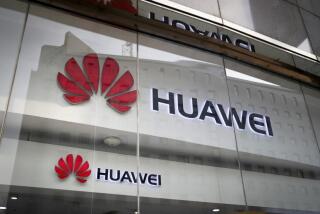IBM to Unveil Advance in Chips
- Share via
IBM Corp. is expected to announce today that its scientists have developed a technique for printing circuitry on silicon that could make computer chips significantly more powerful while extending the life of current manufacturing technology, potentially saving billions of dollars in plant reconstruction.
Most semiconductor manufacturing today uses a process called optical lithography, in which lasers imprint patterns on silicon wafers, much like silk screening, with features as small as 90 nanometers in width. A nanometer is a billionth of a meter.
As components shrink, more can be crammed onto each chip, enabling smaller devices that are increasingly powerful.
Intel Corp., the world’s largest chipmaker, introduced microprocessors on the 65-nanometer node late last year, but the majority of today’s computer processors are still made at 90 nanometers.
Many experts believe that using optical lithography and beaming lasers through water can concentrate the light to produce chips with features down to 32 nanometers, but no smaller.
IBM’s technique, a variation of so-called immersion lithography, is expected to be announced today at a technical conference in San Jose.
It uses an oil-like organic fluid with a higher refractive index than water, resulting in highly focused laser beams that produce lines 29.9 nanometers apart -- about 3,000 times as thin as a human hair.
“This technique could be quite an attractive option to make chips at 25 nanometers,” Gian-Luca Bona, functional manager of science and technology at IBM’s Almaden Research Center in San Jose, said in an interview. It could lead to processor and memory chips that are smaller, faster, cheaper and use less power, IBM says.
By extending the use of optical lithography further into the future, chipmakers can delay switching manufacturing processes, which causes downtime and lost productivity, while buying time for other technologies to mature.
IBM’s process could allow optical lithography to be used through 2013.
“This result is the strongest evidence to date that the industry may have at least seven years of breathing room before any radical changes in chip making techniques would be needed,” said Robert Allen, manager of lithography materials at IBM’s Almaden lab.
That should be welcome news to chipmakers, who want to avoid costly disruption, said Klaus Rinnen, head of the manufacturing group at tech market researcher Gartner Inc. and a specialist in lithography.
“Whenever you can extend something in use for a long time, the industry will always look at this first,” Rinnen said.
The costs and risks associated with retooling chip factories, reeducating workers and productivity loss can be considerable, Rinnen added.
It’s not possible to quantify the cost savings IBM’s new technique could achieve, but new chip factories, known as fabs, cost billions of dollars to build and equip, and retooling them for an entirely new manufacturing method would be extremely expensive.
A senior Intel scientist called the IBM development interesting and worth further study but noted that it was one of several options for future chip manufacturing.
“We’ve been experimenting with immersion lithography but decided that it’s not ready this time,” said Mark Bohr, Intel’s director of process architecture and an Intel senior fellow. “Immersion technology is of interest to us and to the industry, but there are still a lot of issues about defect density, how fast you can control wafer production, etc.”
Intel last week said it had succeeded in producing prototype processors at the 45-nanometer level using dry lithography.
The current roadmap at Intel, which produces more than 80% of the world’s computer processors, foresees introducing a 32-nanometer chip in late 2009.
The company is looking at several ways to manufacture chips at the 32-nanometer node, including immersion technology, extending dry lithography to that scale and using a radically different and as yet unproven technology known as extreme ultraviolet, or “soft X-rays.”
“It comes down to a question of what’s most cost-effective. Is it immersion or dry?” Bohr said. “Right now, immersion tools are about twice as expensive.”
More to Read
Inside the business of entertainment
The Wide Shot brings you news, analysis and insights on everything from streaming wars to production — and what it all means for the future.
You may occasionally receive promotional content from the Los Angeles Times.








